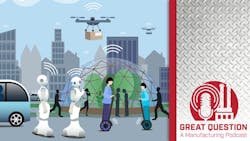Podcast: Cutting-edge, must-see tech — From eyewear-free 3D tablets to Wi-Fi-enabled clothing
In this episode of Great Question: A Manufacturing Podcast, Laura Davis, the editor in chief of New Equipment Digest, explores groundbreaking technologies shaping our tomorrow from energy solutions to retail innovations and immersive entertainment to smart clothing. This episode unpacks the latest developments driving technological progress across multiple sectors.
Below is an excerpt from the podcast:
We've got four new developments to discuss today. The first on the list is related to solar tech.
As big as solar tech currently is, I thought it would be more ubiquitous by now, but I only see applications for it few and far between. That might change though with a new development from Oxford University. Scientists at Oxford University Physics Department have developed a new way to generate solar electricity without the need for silicon-based solar panels with a new power-generating material that can be coated onto the surfaces of everyday objects. The light-absorbing material is thin and flexible, making it possible to apply to almost any surface, including buildings. The technique, developed in Oxford, stacks multiple light-absorbing layers into one solar cell, allowing the surface and materials to harness a wider range of the light spectrum and generate more power from the same amount of sunlight.
According to Oxford, the material has been independently certified to deliver over 27% energy efficiency, for the first time matching the performance of traditional, single-layer, energy-generating materials known as silicon photovoltaics. Japan's National Institute of Advanced Industrial Science and Technology certified the researcher's scientific study. According to Dr. Shuaifeng Hu, a post doctoral fellow at Oxford University Physics, in just five years of experimenting with their stacking or multijunction approach, they have raised power conversion efficiency from around 6% to over 27%, which is close to the limits of what a single-layer photovoltaic can achieve today. He followed up with that the team feels they can get the photovoltaic devices to achieve efficiencies greater than 45% over time. When compared to the 22% energy efficiency of solar panels currently, it seems promising. But the flexible material is also a key player here. At just over one micron thick, it's almost 150 times thinner than a silicon wafer. Unlike existing photovoltaics generally applied to silicon panels, this can be applied to almost any surface.
New materials that can be applied as a coating have demonstrated the ability to replicate and exceed silicon's performance while adding flexibility. This breakthrough is significant because more solar power can be generated without relying so heavily on silicon-based panels or dedicated solar farms. The researchers believe that this innovative solar material and technique could provide a new platform for the industry by reducing the need for silicon panels and purpose-built solar farms as these materials can be manufactured and placed on existing buildings, vehicles, and objects, increasing sustainability and saving costs.
Oxford PV, a UK company spun out of Oxford University Physics in 2010 by co-founder and chief scientific officer Professor Henry Snaith to commercialize perovskite photovoltaics, recently started manufacturing perovskite photovoltaics at its factory near Berlin, Germany. This is the world's first volume manufacturing line for 'perovskite-on-silicon' tandem solar cells. They hope that the UK government, specifically the newly created British Energy department, will start considering commercializing this innovation as they see it as the only real growth avenue.If commercialization takes off, maybe I'll be able to buy a solar panel coating and stick it to myself to give me more energy. That's my hope.
Ok, on to number two. This new tech deals with grocery shopping, and you're probably not going to be able to guess what it entails.
Researchers at Seoul National University of Science and Technology (otherwise known as SeoulTech) in Korea have created a flying shopping cart. Ok, the real name for it is an aerial cargo transportation solution and it's called the Palletrone. It's a cargo platform mounted on top of a multirotor drone. Given that it can fly, well in actuality it hovers and you still have to hold onto it, but it would remove the rage that comes with grabbing a cart that has a funky wheel and pulls to one side and not realizing until too late. I'm not taking that cart back—I will suffer silently.
The team published their findings in IEEE Robotics and Automation Letters in August 2024. They wrote that to facilitate physical human-robot interaction, we employ an admittance control technique. Instead of relying on complex force estimation methods, like in most admittance control implementations, we introduce a simple yet effective estimation technique based on a disturbance observer robust control algorithm. We conducted an analysis of the flight stability and performance in response to changes in system mass resulting from arbitrary cargo loading. Ultimately, we demonstrate that individuals can effectively control the system trajectory by applying appropriate interactive forces and torques.
About the Podcast
Great Question: A Manufacturing Podcast offers news and information for the people who make, store and move things and those who manage and maintain the facilities where that work gets done. Manufacturers from chemical producers to automakers to machine shops can listen for critical insights into the technologies, economic conditions and best practices that can influence how to best run facilities to reach operational excellence.
Listen to another episode and subscribe on your favorite podcast app
About the Author
Laura Davis
Laura Davis is the editor in chief of New Equipment Digest (NED), a brand part of the Manufacturing Group at Endeavor Business Media. NED covers all products, equipment, solutions, and technology related to the broad scope of manufacturing, from mops and buckets to robots and automation. Laura has been a manufacturing product writer for six years, knowledgeable about the ins and outs of the industry along with what readers are looking for when wanting to learn about the latest products on the market.
